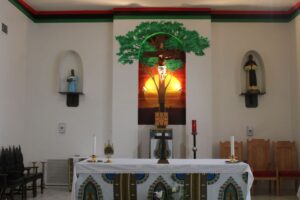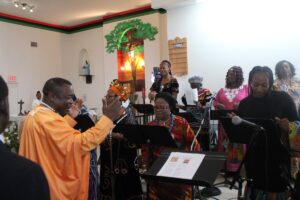Known for its strength and stability even in harsh climates, Sacred Scriptures reference the Acacia Tree throughout its pages, notably in being used to build the Ark of the Covenant in Exodus. A plant native to Africa, it has long been associated with the Black Catholic community in the United States.

In preparation for its second annual Founders Day Celebration June 9, St. Josephine Bakhita Mission Parish near downtown Phoenix, brought this symbolism to the forefront in artistic restoration of its interior, which includes a mural of the tree behind the tabernacle. The church’s crucifix hangs in front of it, in the middle of the sanctuary, as if the wood of the cross is connected to the wood of the tree.
“It invites people to a deep reflection. You make that connection with the African heritage and the theme of the tree of life and Christ’s life-giving death,” reflected St. Josephine pastor Fr. Andrew McNair. “Through the cross, life is born. It’s very Christo-centric. At the heart of it is the faith, Jesus Christ. That’s the most important message for us, to make disciples. The space is evangelizing, it’s welcoming.”
Also depicted in the mural is the sun over a field, reminiscent of the African horizon. Surrounding the ceiling is a painted banner depicting the Pan-African colors: red for the blood of the ancestors, black for the peoples of the African continent and green for the abundant natural resources of Africa.
“Art is very important because the human heart is made not only for truth but also for beauty. When there’s so much doubt about truth and people rejecting that there is such a thing as truth with relativism, beauty can disarm them, beauty can attract them, it can give them a sense of the eternal,” said Bishop Emeritus Thomas J. Olmsted, who celebrated the Mass. “Cultivating that sense of beauty — as they’re doing here in this church — it’s really very significant to have symbols especially connected with our faith, and then with a saint like St. Josephine Bakhita. It just helps people believe we could also grow in holiness.”
Tying into the connection between the African American community and the African continent, the liturgy also witnessed the debut of the parish’s third choir —


the Choir of St. Joseph, a traditional African choir. Esther Folefac, who is originally from Cameroon, is a member of the Christ the King Choir and Our Mother of Sorrows Parish in Tucson. She and her family drove to Phoenix to join their friends in leading the music. As she danced in procession, she shook two shekeres — maraca-like traditional West African instruments. Even her granddaughter, Abigail, joined in the celebration by playing the drums.
“Our great grandparents actually did their own kind of worshipping. When we grew up, Pope John Paul II came and incorporated the African culture — their way of worship — into the Western way of worship,” she said. “It makes us feel free, and we know that we are celebrating our creator wherever we are in our own way. It makes us feel good and happy.”
During the celebration, seminarian Ulengabo Mangye served his first Mass at the parish where he has been assigned for the summer. He found the liturgy reminiscent of how he grew up worshipping in the Democratic Republic of the Congo and Tanzania.
“The music, how people receive the joy of the Gospel, it’s just amazing, especially today when we heard the choir singing,” said Mangye, who come from St. James the Apostle Parish in Glendale. “Being here, it’s kind of enlightening my vocation that these might be the people I’m going to serve in the future.”
Sr. Jessica Ramirez, a Daughter of Charity of St. Vincent de Paul, joined members of her community and other consecrated religious in participating in the Founders Day Liturgy. Originally from Nevada, Sr. Jessica has been in the Diocese of Phoenix for a little less than a year and attended St. Josephine for the first time that day.
“I thought it was beautiful. What a chance to get to experience a community that is part of the larger Catholic Church but is maybe not my home community,” said Sr. Jessica, who serves at the Society of St. Vincent de Paul main campus in South Phoenix. “I loved all the dancing. I think any church that has so many young people in it and so alive with dancing is a church that stays alive.”
Guest homilist Fr. Fidelis Igwenwanne, who serves as chaplain for the Phoenix Veterans Affairs Health Care System, reflected on the life of St. Josephine Bakhita, noting her journey from being forced into slavery from the Sudan to eventually becoming a mother superior for a community of Canossian Sisters in Schio, Italy.
“Remember the mantra: humility takes you very far,” he said, noting the uniqueness of an African woman leading a religious community in Italy.
“The life of your patron saint, Mother Josephine Bakhita, echoes the message of the Second Reading today, where St. Paul reminds us that despite the hardship of affliction we may face in this life, we have the hope of eternal life,” added the Fr. Fidelis, who is originally from Nigeria. “Let us take to heart the Good News, that no matter how deep our sins are, God’s love and mercy are deeper still.”
Another piece of art — an image of the African continent — is set to be installed on the ceiling of the church by June 18, Fr. McNair said. This artistic restoration is the first of many that the pastor and community hope to incorporate into the near-90-year-old building to enhance the worship experience through culture and reverence. Included in that hope is a potential Afro-centric rendition of the Stations of the Cross as well as stained-glass windows depicting Black saints and those on the path to sainthood. These renovations add to an overall sense of home in the community, he said.
“Several people mentioned to me, ‘This really feels like ours’,” said Father McNair. “It’s a great sense of community and appreciation for what God has given us. The whole notion of the anniversary is that God has given us a home, and that’s what we’re celebrating. A sacred place to worship.”






